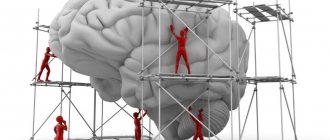This article was developed under the heading: Psychology.
Section: Society.
Quite often you can hear the phrase “You are like this because you all have such a mentality.” The peculiarities of mentality are revealed in various works, art, and literature. Many writers write about that very generally accepted mentality of the Russian people. But what does “mentality” mean? Can it affect the human psyche? How does this affect our personality? This is exactly what our article is about today.
Let's look together at what human mentality and mentality are.
What is human mentality
In the scientific literature, the term “mentality” is described in different ways. Some people view this phenomenon as a special worldview. Others define mentality as a concept of the cultural (collective) psyche.
Mentality comes from the Latin word "mens", which means "soul". Mentality is a warehouse of character, ideas, worldview, mental ideas about the world that are characteristic of a particular culture, nation, people.
In this definition, it is important to focus on the fact that the mentality is specific to a people or nationality. What does it mean?
Now there is a large percentage of migration in the world, so countries are mostly multinational. Moreover, at the present stage of history, cultures are mixed, taking on new forms and ideas. Therefore, it is impossible to talk about the original preservation of the “national mentality”. If you look at Russia, you will see how many different nationalities inhabit it. Each such nation or people has its own historical cultural goals and vision of the world. But despite his nationality, a person who has lived in Russia acquires common and characteristic features for all.
Thus, mentality is the characteristics of behavior and outlook on life of a particular nationality or population.
History of the term.
The term “mentality” was used back in the 19th century. American philosopher and poet R. Emerson (1803–1882), who tried to connect together the metaphysical and psychological problems of public sentiment. The concept of “collective mentalities” was also used by the French politician and historian A. de Tocqueville, author of the book Democracy in America
(1835), who sought to find the root causes of the prejudices, habits and preferences common in the American society he described.
The term “mentality” was introduced into scientific circulation by the French ethnologist and socio-anthropologist L. Lévy-Bruhl (1857–1939), who studied pre-logical thinking and “collective ideas” (or “mentalities”) so-called. "primitive peoples" L. Levy-Bruhl considered the characteristic feature of mentalities to be inexplicability with the help of ordinary logic and common sense, “mysticism” (also emphasized by the “father of sociology” E. Durkheim), and the participation of everyone in universal beliefs or misconceptions (the so-called “law of participation”, loi de participation). He was the first to emphasize the difficulty of trying to understand the collective life of unliterate peoples based on modern concepts.
Philosophical
the understanding of the concept of “mentality” is associated with the name of the German neo-Kantian thinker E. Cassirer (1874–1945). He put approximately the same content into the concept of “mentality” as L. Levy-Bruhl, emphasizing that the types of mentalities can be systematized according to the ways of perceiving the surrounding world, especially, as he believed, nature.
Psychoanalytic
and the sociopsychological research
tradition
within which psychohistory was born tended to present mentality as an analogue and synonym for “social character.”
Neo-Freudian sociologist E. Fromm (1900–1980) in his work Flight from Freedom
(1941) used the concept of “social character,” considering it synonymous with the concept of collective ideas or mentalities.
The French psychologist G. Boutul believed that mentality - as a set of ideas and intellectual attitudes - is located between a person and the world he perceives “like a prism” ( Mentality
, 1952).
In the middle and second half of the 20th century. the concept of mentalities was actively used in the philosophical systems of phenomenologists and structuralists, who introduced into the linguistic norm the term “episteme” (cognitive system and mental picture of the world), which is close in content to the concept of “mentalities.”
Fundamentals of socio-historical
considerations of mentalities are laid down by the French historical school. It was she who forced us to begin a scrupulous development of the history of concepts that shape the lives of people in society and prove that their changing content is an inseparable part of culture.
According to the vision of the prospects for recreating bygone centuries by the “new historical science,” one of its founders, L. Febvre, believed that the historian is capable not so much of reconstructing the objective world (gone once and for all!), but rather of recreating the world view and mentalities of the people being studied them of the era, i.e. their subjective assessments of the world with all the realities important to them, including gods, demons, etc. L. Febvre, who founded the Annales school together with M. Blok, saw in collective mentalities not so much biological as social foundations, nature and determinants. Seeing in them the processes of “secondary recoding” of the picture of the world with the help of sign systems, L. Febvre and M. Blok were the first to show the possibility of deciphering these semiotic embodiments: “The historian must strive to discover those mental procedures, ways of perceiving the world, habits of consciousness that were inherent in the people of a given era and about which these people might not have been clearly aware, using them as if “automatically”, without reasoning about them, and therefore without subjecting them to criticism,” noted M. Blok in one of his works .
Thus, the French historians, who stood at the origins of the study of the “history of mentalities” as an independent direction, placed the “mental” between
conscious, obviously structured, reflected (that is, forms of social consciousness - religion, ideology, morality, aesthetics, etc.) and unconscious (unconscious) in the collective, and partly in the individual psyche of people. The most important, constructive sphere of mentality is the “sphere of ideas about a person” (R. Sprandel).
Examples
You've probably already heard about specific examples. But let's look at a few specific and fairly familiar examples to everyone.
Russian
Of course, what the Russian mentality is is different in the perceptions of Russian residents and foreigners. But here’s what can characterize the mentality in Russia:
- Lack of value for personal boundaries and privacy. This is not only common on social media, where most people try to find out about the personal lives of others. But also in ordinary neighborly relations. For example, neighbors may be annoying, not paying attention to the fact that you may have personal matters. Although, of course, every year this trait becomes less and less characteristic;
- The desire to isolate yourself from strangers. Although this contradicts the previous point, a Russian person strives to simultaneously learn about others, but at the same time protect himself from prying eyes. An example is high fences on private plots. In Europe and America, fences are generally not common. But in Russia, everyone strives to build a high and dense fence on their site;
- Broad soul. A Russian man with a truly broad soul. Which is also common in other CIS countries, for example, Belarus;
- "Sad Russian look." Although this is a kind of joke on the Internet, it really characterizes a Russian person. On the streets everyone is gloomy, sad, everyone is in their own thoughts. And these thoughts are most often negative.
Mentality is, in simple words, how people see the surrounding reality
In Germany
For comparison, let's look at how German residents behave. They, unlike Russian people, respect their own and other people’s space. They are more conservative and secretive in their emotional and spiritual manifestations. The Germans are also more careful.
Natural-geographical factors of influence
The dependence of national characteristics on natural and geographical conditions is called geographical determinism. The natural environment affects the mentality of the people through its influence on the way of life (steppe or forests, cold or hot climate), as well as through images of native nature imprinted in the mentality (for example, the love of freedom of the Mongolian peoples was influenced by the lack of physical boundaries of their territory).
Also, three factors such as geographical location, vastness of territory, and climate are separately identified and explained using the example of a Russian person. The first Russian factor is breadth of soul, the second is hospitality and some melancholy, the third (namely long winters) is contemplation and dreaminess.
Main types
Special models of mentality are also identified, which are referred to as “types of mentality.” Let's take a closer look at these types of mentalities.
Personality mentality
Personal mentality is those value guidelines formed in a person that are characteristic only of him, his family, relatives, as well as people who live nearby. It is formed in the process of life and takes into account the characteristics of life itself. These features include climatic, cultural, geographical and political factors.
Public
Social mentality is the mentality that is characteristic of a particular social group. Here we are talking not only about the national mentality, but also about the professional one, for example.
The public mentality is formed historically. Of course, it is influenced by similar factors and reasons for its formation. Some examples of public mentality can be identified:
- Teachers' mentality. For example, there are specific standards of conduct for teachers. You have probably noticed more than once how similar all our school teachers are. Sometimes they even say the same phrases;
- English mentality. It is characteristic of the peoples of England. They are so independent from others that a person living in England can be recognized immediately.
In simple words, mentality as a term has become broader, including various professions and social groups
Levels
National mentality is a two-level phenomenon. The first level is genetic. For example, in the course of numerous studies it was found that the genetic peculiarity of the Russian person is a priority in the thinking of the right hemisphere. This kind of thinking is characterized by creativity and sensuality. It is not for nothing that the Russian language is considered one of the richest and most beautiful languages.
The second level of national mentality is the acquired (or individual) mentality. The learning process, upbringing, personal self-realization, choosing one’s own role, assimilation of culture, self-identification, etc., are all the formation of the second level. Here it is important to take into account the individual psychological characteristics of a person. He can accept the national characteristics of his ethnic group, or, on the contrary, he can develop a critical attitude towards them.
General typology of mentalities
The typology of mentalities differs from the concept of “types” in that these mentalities are characteristic of absolutely all peoples and nationalities. The only difference is in what historical period preceded the formation of this mentality. We can say that this relates by analogy to the historical “formations” through which each state passes. Let's look at these types of mentality and the periods in which they were formed.
Barbaric
As the name suggests, barbarian mentality is characteristic of a wide variety of civilizations. Every civilization known today has lived through this mentality.
Here's what characterizes this type:
- Praise of physical strength;
- Lack of self-preservation instinct, fear of death;
- Religiosity (polytheism);
- Nomadism.
Feudal
Feudal means the next stage in the formation of human society and the state. It is also called the aristocratic mentality. At this stage, society is stratified into classes. Poorer and richer people appear. Because of this, there is a division of society, which also affects culture, science, education and the development of the individual as a whole. Transition to monotheistic religions. Mental abilities also develop. The so-called aristocracy of society appears.
Bourgeois
Bourgeois replaces feudal and is characterized by the following features:
- Spread of education;
- Increasing the value of every human life;
- The stratification of society continues, it becomes more complex;
- Openness of society and culture;
- Development of science and education;
- People strive for development.
Modern or post-industrial
This is the mentality that characterizes humanity today. Of course, if we do not take into account some countries that are at different stages of state and social development. Today, tolerance, tolerance, acceptance of everyone, community, openness not only of individuals, but also of states as a whole are widespread.
Each state and society went through certain stages in the formation of mentality
Socio-historical factors of influence
The socio-historical factors in the formation of mentality are numerous and varied. Therefore, let’s look at the most frequently mentioned among them. For example, the mixing of different peoples, as a result of which hybrid mentalities appear. Frankly speaking, all currently existing mentalities in society are hybrid, so it is simply impossible to find a genetically pure people. For example, researchers talk about the influence of the Tatar-Mongols on the formation of some Russian traits. For example, after the Tatar invasion, the Russian people developed a tendency towards robbery and rebellion, and disrespect for private property. But, on the other hand, such positive qualities as resilience and the ability to endure the difficult hardships of life have developed. In general, we can distinguish three main mechanisms of influence of interaction between peoples on their mentalities:
- unification of gene pools;
- borrowing cultural practices;
- the formation of national character traits necessary to counter foreign invasions and adapt to their results.
How mentality affects development
The main question is “Does mentality affect us as individuals?” The answer is clear - yes, mentality influences who we are. Here's what contributes to this:
- Where we grew up, in what family, under what conditions always affects our character, level of psychological health, abilities for social connections and interactions;
- The level of education indicates how we think and how broadly;
- Culture. The cultural characteristics of a particular place of residence allow us to say what ideas we have about life.
Thus, mentality is a component of our personality. If a person from Russia was born and raised in a completely different country, a different culture, then most likely he would become a different person.
Religious influences
National mentality is largely the influence of religion. In sociology, it is believed that Islam, Western and Eastern Christianity and Judaism influenced the formation of four major mentalities. For example, for Jews even in our time, the Jewish mentality with special, dogmatically determined and fixed by thousands of years of national tradition attitudes of faith, thinking and will is important. Social and political ideas, values, identity, systems of relationships and characteristic types of behavior largely determine the worldview of the Jewish nation. There is an opinion that religion has been adapted to the mentality. But it was not formed on its basis. Since our society, due to its great diversity, does not have a clear answer to this question, it will remain the subject of long future debates.
How to change your mentality
But can it be changed? For the most part, it is impossible to fundamentally change this. Since we grew up in this psychological environment. What we absorb in childhood remains with a person for life. Of course, if you radically change your place of residence or religion, your views may change. But the original mentality will still be preserved.
It is important to note that in life there are still deviant individuals whose mentality is rather vague. They are weakly influenced by external factors in the form of social beliefs and principles. They attach little importance to it or ignore it altogether. An important role for deviants is played by their subjective understanding of the world.
Target
historian of everyday life - studying people's worldview from the point of view of their own perception. However, a modern historian has to use for this purpose the conceptual apparatus, theoretical schemes and models that have developed by now, and constantly compare the differences in the content of established and only seemingly unchangeable concepts. The constant comparison of the “external” point of view, determined by the modern system of knowledge, with the “internal” point of view inherent in the people of the era under study, creates a situation of a new vision of history, the so-called. “stereoscopic vision” (A.Ya. Gurevich). This allows us to preserve the principle of historicism and avoid transferring modern ideas into the era being studied.
To sources
, reflecting hidden mental structures and complexes of collective ideas (unconscious, unreflected) - can be attributed to “everything created by man and retaining the spiritual essence of its creator” (P. Dinzelbacher). Therefore, almost all types and types of sources, both written and folklore, ethnographic, archaeological, numismatic, etc. may be involved in the research. However, materials of personal origin are of greater importance - wills, diaries, letters, memoirs, autobiographies, works of art that reflect the worldview of their authors. For researchers of mentalities of the recent past, “oral history” (which also formed a separate direction in the 1960s) is of great importance - interviews of all types (narrative, semi-structured, biographical, leitmotif, focused, etc.). “Oral histories” collected by a historian of mentalities, from a collection of facts common in traditional research, are transformed into a new type of empirical material, structured according to themes and chronology of the so-called. "secondary source".
How is it different from mentality?
Often these concepts are confused and used for other purposes. Although in reality they are quite similar.
Mentality
A vision of the world, peculiarities of perception and value systems characteristic of a large group of people. Mentality manifests itself in a specific group of people.
Mentality
It may be characteristic of society as a whole. This is how we perceive our surroundings through emotions. The mentality can be the same for completely different mentalities.
Concept
National mentality is a certain style of life and culture inherent in a particular ethnic group of people, as well as a national system of values, views and worldview of a nation, and general character traits.
Stability, immutability, constancy, conservatism are the characteristic properties of the mentality of a nation. It is difficult to influence it through ideological, administrative, legal or management measures.
Americans
Americans have a spirit of rebellion. What else:
- optimism;
- hard work;
- thirst for success;
- cult of strength and youth;
- craving for equality;
- strict adherence to rules and order;
- increased need for comfort.
It is important to remember that the culture of the country, the state of society, and state policy, although they influence each individual person, do not determine his mentality. This is just one of the factors, and therefore one cannot think only in stereotypes and lump everyone with the same brush.
Features of the national way of thinking
Stereotypes about the national worldview are perhaps among the most popular. Remember how many jokes have been made about the Estonian, American, Russian or German way of thinking. Let's look at the mental characteristics of some nations.
English
Features of the English way of thinking:
- self-irony;
- self-esteem;
- diligence;
- activity;
- strictness in raising children;
- determination;
- durability;
- the ability to challenge fate and oneself, take a blow, lose;
- restraint.
French people
Features of French thinking:
- wit;
- eloquence;
- non-conflict;
- increased control over emotions;
- secrecy regarding personal life;
- sophistication.
Spaniards
Peculiarities of the Spanish worldview:
- individualism;
- pride;
- a heightened sense of justice;
- sense of honor, patriotism;
- openness;
- life according to the “here and now” principle.
Study methods
mentalities are very diverse. Since mentality is “something inexpressible that cannot be written out from the source text and that can only be revealed by the researcher from the opinions and judgments expressed by the author of the text under study” (F. Graus) - the historian is forced to use not only historical, but also many other techniques and methods – psychological, ethnological.
Since ordinary people of the distant past practically did not leave any ego-documents (personal sources - letters, diaries, memoirs), the historian has to analyze the entire range of sources that could reflect their way of thinking and value system. He has to ask the sources who recorded the statements or assessments of these ordinary people the questions that ethnologists working with living respondents usually ask. This method was called “historical-ethnographic”.
The history of mentalities borrowed a number of analytical techniques from semiotics, which developed ways of understanding foreign culture by searching and analyzing symbolic (semiotic) forms - words, images, institutions, actions, through which people in certain circumstances represented themselves and other people. A researcher of mentalities has to interpret the meanings and symbols associated with the objective world and the world of phenomena through the world of reality close to the experience of people of the past - the world of everyday life, ordinary speech, habitual actions (Yu.M. Lotman). Recently, one of the ways of researching the history of mentalities has become the analysis of discursive practices (primarily dominant discourses), which are understood as “practices of speech behavior” (M. Foucault) - that is, methods, rules, logic of discussing something verbally and nonverbally ( language of actions and gestures) by.











